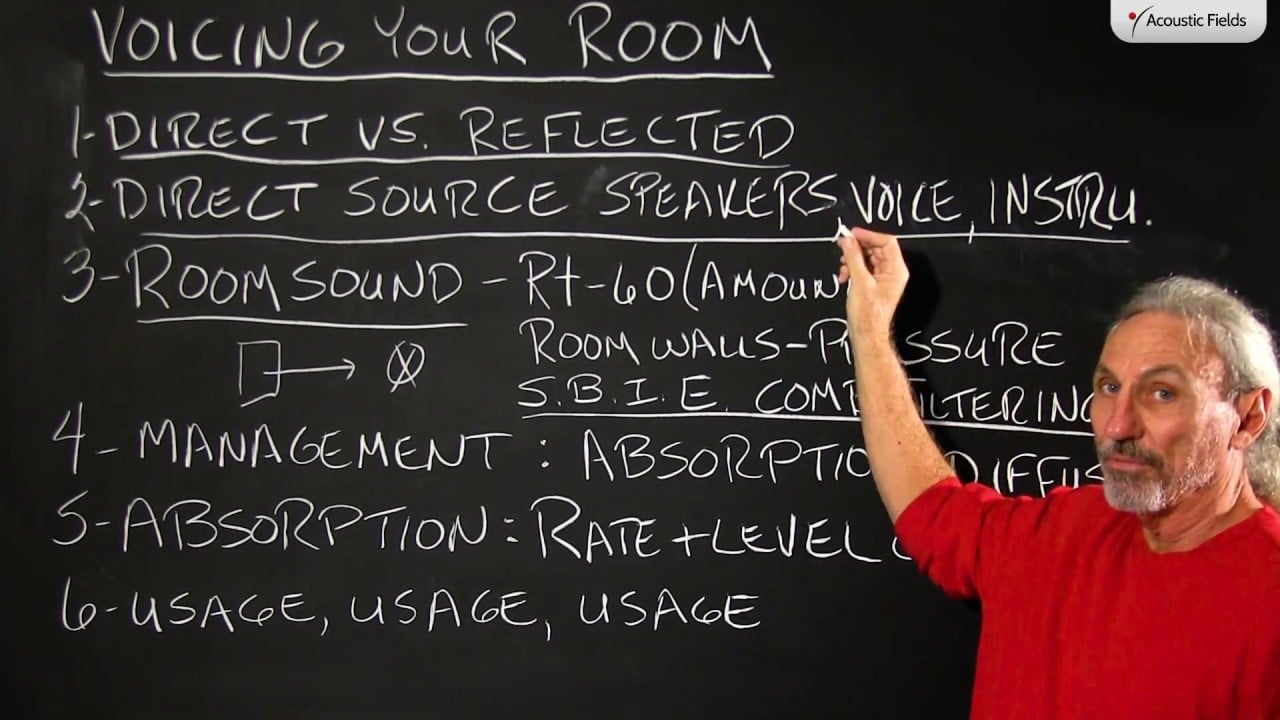Voicing your room – what does that mean? It’s kind of a weird set of words, voicing your room, but we all know and have heard these terms before. We want to make our room work for what we’re trying to do musically, vocally, whatever our usage is, we’re trying to get the room to work with our usage and we all know from past videos that size, volume, treatment all of these issues are important so let’s just kind of break down some of those issues in the voicing process and look at them.
First issue we have is direct versus reflected energy, so we have sources and our sources are speakers, voice, instrument, whatever the sound generating source is we’re always going to have and I mean always, without exception a balance between direct versus reflected energy. So if we have a speaker we’re going to have the direct energy to the listening position and then we’re going to have all the reflections within the room so for working in rooms we’re always going to have that direct versus reflected energy balance and that’s critical to our usage and it’s critical to what we’re doing in there. Too much reflected energy at the microphone position leads to too much room sound, not enough direct energy leads to a weak source and no impact on vocals if you’re in a voice room so it’s always a balancing act between direct versus reflected energy and we have to remember that our sources are the source so to speak of the direct energy.
So what do we have for room sound, well our room is the worst nightmare because it has all of these issues, it has reverberation time. We put energy in it and then we have to sit, across our arms, tap our feet so to speak, wait for the energy to decline so that we can add more energy and this is an oscillating type of situation, fundamentals, harmonics, everything living and dying so to speak on its own volition with minimum impact by the room. So we have pressure issues because of our boundary surfaces, our size and volume, we have combed filtering, we have all kinds of issues in the room, we’ve done many videos on the room impact. So voicing your room is a process where we take the direct energy from our source and the reflective energy from our room and achieve a balance and that’s the critical part. Some people, some rooms do it way better than others, that’s the difference between good and bad rooms. If you walk into a room and you go wow this is really a good room it’s because they’ve taken that direct versus reflected energy ratio into consideration. What are our treatment options? The standard 2, I wish I could think of a third but there aren’t any, we’ll have to go to another planet.
So we have absorption and diffusion and here’s something that we really have to be careful of when we’re voicing our rooms, no matter what the usage is the rate and level of absorption is critical. There’s a lot of information, a lot of misinformation in the literature: just use building insulation, just use foam, just use blankets, egg cartons… so the bottom line here is rate and level is critical. There is no one sound absorption rate and level that works for every usage, they’re all different. Sidewall reflections need different time signature management in control rooms versus listening rooms. They need different time signature management in vocal rooms versus control rooms; everything is different so having a sound absorption technology with predictable rates and levels of absorption is critical.
Knowing what rate level to match to usage is even more critical, once again the difference between a good and a bad room is somebody knew what they were doing with rates and levels. Usage, usage, usage… just like real estate, location, location, location… usage, usage, usage…. When you’re voicing your room you have to take all of that into consideration. Direct versus reflected, proper treatment, manage the issues and you’ll get a room that sounds and matches what you’re trying to accomplish.
—
This is an unedited transcript from our video series from Acoustic Fields. There will be some errors in grammar and sentence structure that occur during this translation process.
For complete understanding and comprehension, please view the video which is included in this text. For any additional information regarding this topic or others relating to room acoustics, please contact us directly at:
P: 520 – 392 – 9486








He Dennis, thanks for all the information, after viewing several videos with all the explanations regarding small rooms we (a small group of musicians) came to the conclusion that our situation is hopeless. As you may know with computers every musician is tempted to record, produce, mix and do the mastering of their music. Unfortunately for many of us achieve good sound in a room that is in the red zone is not an option, BUT it may be a work around for this … it is headphones… so we wanted to ask you what are your thoughts about using headphones for mixing – mastering music in a desperate situation or as a work around , hope you’ll talk about it, many thanks for sheering your work with people.
E, Headphone sound and room sound are two very different approaches to listening to recorded sources. Headphone sound is all about resolution, separation, and definition with no room sound. Room sound has all of those components as well with presentation added. You have to decide what works best for you and your goals with music.